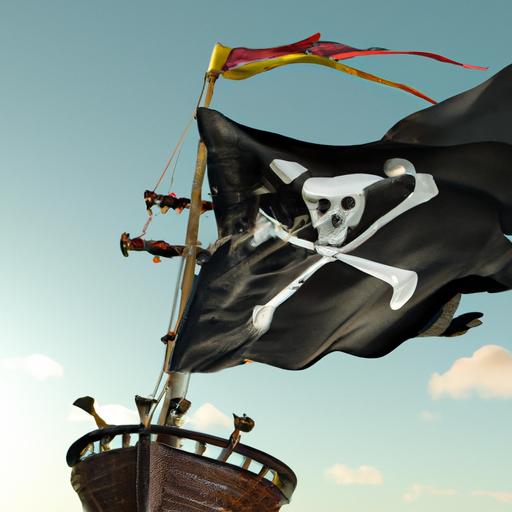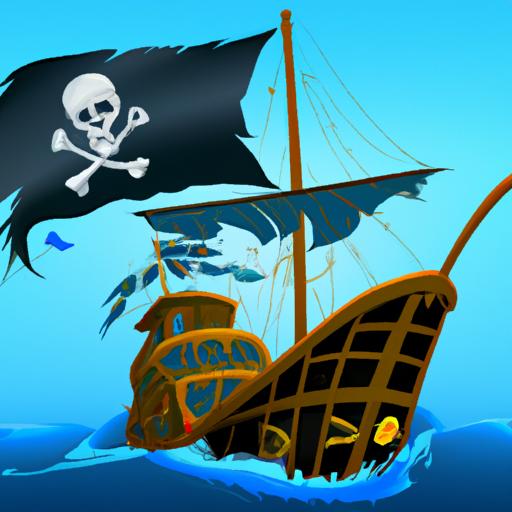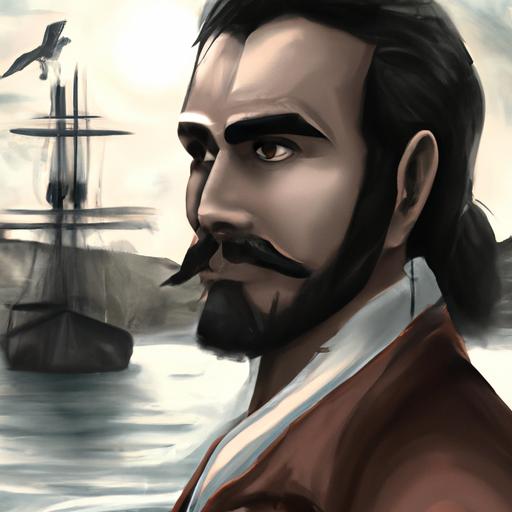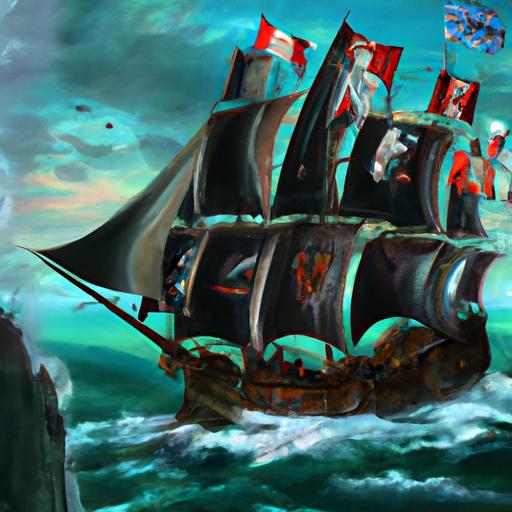This article may contain factual errors. It was created by the openai-ghostwriter 1.0.2. This is a python script for automatic generation of web pages powered by the OpenAI's GPT-3.
Dieser Artikel kann Unsinn und falsche Aussagen enthalten! Er wurde vom openai-ghostwriter 1.0.2 erzeugt. Das ist ein Python-Skript für die vollautomatische Erstellung von Webseiten.
The Age of Piracy

Ahoy, me hearties! Welcome to the Age of Piracy. 'Tis a time of adventure and danger, of exploration and excitement. A time when brave captains and their crews set sail for distant lands in search of treasure and glory. A time when the seas were ruled by rogues and outlaws, by daring buccaneers and swashbuckling corsairs.
The Age of Piracy began in the early 17th century with the rise of privateering. Privateers were privately owned ships that were authorized by governments to attack enemy vessels during wartime. This allowed governments to wage war without having to maintain large navies. The privateers would be issued letters of marque, which gave them legal authority to seize enemy ships, loot their cargo, and keep the proceeds.
As privateering became more popular, many sailors turned to piracy as a way to make a living. These pirates plundered merchant ships from all over the world, amassing great wealth in the process. They also established pirate havens on islands such as Tortuga and Nassau where they could repair their ships, trade goods, and recruit new crew members.
Pirates were often feared for their ruthless tactics but they also had a code of honor among themselves. They elected captains who had final say over all decisions on board their ship. Pirates also shared any loot they acquired equally among the crew members.
The Age of Piracy lasted until around 1720 when most European nations began cracking down on piracy with naval patrols and harsher punishments for those caught engaging in it. But even today there are still remnants of this era in our culture with movies like Pirates of the Caribbean and books like Treasure Island.
So set sail on your own adventures! Who knows what treasures you may find? Just remember: Dead men tell no tales!
History of Piracy

Ahoy, me hearties! Welcome to the age of piracy, a time when brave and daring buccaneers roamed the seven seas in search of booty. From the Caribbean to the Indian Ocean, these salty sea dogs plundered ships and raided coastal towns in pursuit of riches. It was an era full of adventure and danger, with pirates facing off against powerful navies in epic battles for control of the high seas. So grab yer cutlass and join us as we explore this thrilling chapter in maritime history.
Early History
Back then, piracy was a way o' life fer many sailors. With no laws or regulations to keep 'em in check, they had free reign over the oceans. They plundered ships, stole cargo, and even kidnapped passengers fer ransom. The first recorded pirate attack was in 1511 off the coast o' Hispaniola. The Spanish were so outraged that they sent out a fleet o' ships to hunt down these scallywags. But it didn't do much good; pirates continued to terrorize the seas fer decades. By the 17th century, piracy had become an organized business venture. Pirate captains recruited crews and formed fleets that roamed the waters lookin' fer loot. They even established their own codes o' conduct and rules on how to divide up their plunder. Pirates also had their own hideouts where they could restock supplies and repair their ships after a successful raid. Some of these havens included Nassau in the Bahamas and Port Royal in Jamaica. These buccaneers weren't just after money either; they wanted revenge against those who wronged them or took away their freedom. Many pirates were former slaves or sailors who had been mistreated by their captains. One of the most famous pirates from this era was Edward Teach, better known as Blackbeard. He terrorized ships off the coast of North Carolina for several years before finally being killed in battle with British forces. Another notorious pirate was Henry Morgan, who raided Spanish settlements along the Caribbean Sea during his career as a privateer for England's King Charles II. The Age of Piracy came to an end by the 18th century due to increased naval patrols and stricter laws against piracy. But its legacy still lives on today through books, movies, and stories about these daring adventurers.Golden Age
The Golden Age of Piracy began in the early 1700s and lasted until about 1725. During this time, piracy flourished as never before. The Caribbean Sea was particularly rife with activity as pirates sought out merchant vessels laden with valuable goods. They also targeted Spanish galleons carrying gold and silver from the New World back to Europe. In addition to plundering ships, many pirates also raided coastal towns and villages, taking whatever they could find. One of the most famous pirates during this era was Edward Teach, better known as Blackbeard. He terrorized ships off the coast of North America between 1716 and 1718. His fearsome reputation was so great that even experienced sailors were said to have been afraid to sail near him. Other notable pirates included Anne Bonny, Mary Read, Henry Morgan and Bartholomew Roberts. Life aboard a pirate ship could be both dangerous and exciting. Pirates often fought amongst themselves over food or treasure, leading to violent clashes on board. Discipline was harsh; those who disobeyed orders were often punished severely or even marooned on an island with no hope of rescue. Pirates also had their own unique code of conduct which governed how they treated each other and their captives. For example, it was forbidden for any pirate to harm another without just cause or steal from his fellow crewmates. Captives were usually treated fairly well; if they cooperated with their captors they would often be released unharmed after giving up all their possessions. Despite their ruthless reputation, many pirates actually had a strong sense of loyalty towards each other and would go out of their way to help those in need. This is evidenced by stories such as that of Stede Bonnet who was rescued by Blackbeard after being abandoned by his own crew. The Golden Age eventually came to an end as governments cracked down on piracy by offering rewards for captured criminals or pardons for those willing to surrender peacefully. By 1725 most major pirate havens had been eliminated and piracy had become much less profitable than it once had been. Today we remember this era fondly through books, movies and television shows that romanticize the lives of these daring adventurers who sailed across the world in search of treasure and glory!DeclineIt all began with the rise of powerful navies in Europe and America. These navies were equipped with better ships, more advanced weaponry, and highly trained sailors. This gave them an advantage over the pirates who had no such resources at their disposal. The navies were able to hunt down and capture or kill many of the most notorious pirate captains. The decline of piracy was also due to changes in international law. In 1717, Britain passed the Piracy Act which made it illegal for any British subject to commit acts of piracy against other nations. This was followed by similar laws from other countries around the world. As a result, it became increasingly difficult for pirates to find safe havens where they could hide out or sell their loot. In addition to legal changes, technological advances also played a role in the decline of piracy. By the late 1700s, ships had become faster and more maneuverable thanks to improvements in sail technology and navigation instruments like compasses and sextants. This allowed naval vessels to quickly catch up with pirate ships that were slower and less maneuverable. Finally, there was a shift in public opinion towards pirates during this period as well. People began to view them as criminals rather than romantic figures as they had been portrayed in popular culture before this time. This negative perception made it harder for pirates to recruit new crew members or find support from local populations. All these factors combined led to a dramatic decrease in piracy by the early 1800s. While some isolated incidents still occur today, they are far less common than they once were due to increased naval presence on the high seas and improved international laws. So there ye have it me hearties - the tale of how piracy declined from its heyday in the 1600s until its near extinction today!Famous Pirates

Ahoy, me hearties! Welcome to the age of piracy! A time when brave buccaneers roamed the seven seas in search of booty and adventure. From Blackbeard to Anne Bonny, these famous pirates have become legendary figures in history. They were feared by many and respected by all. So raise yer mugs and join me in a toast to these swashbuckling scoundrels who made their mark on the world!
Edward Teach
Blackbeard was born in Bristol, England in 1680. He began his life at sea as a privateer for Queen Anne's War and later joined a group of pirates led by Benjamin Hornigold. It was under Hornigold's command that Blackbeard gained fame and notoriety as a fearsome pirate captain. Blackbeard quickly earned a reputation for being ruthless and cruel. He was known for his intimidating appearance, which included braiding his long black beard with ribbons and tying lit fuses into it. This gave him an even more terrifying look when he boarded enemy ships. Blackbeard also had a knack for strategy and tactics, often using psychological warfare to intimidate his enemies before battle. He would often fly flags featuring skeletons or other symbols of death on his ship, creating an atmosphere of dread among those who encountered him. In 1717, Blackbeard captured a French slave ship called La Concorde off the coast of Martinique. He renamed her Queen Anne's Revenge and used her to terrorize merchant vessels in the Caribbean Sea and along the American coast. During this time, he also formed an alliance with Charles Vane and Calico Jack Rackham. In November 1718, Blackbeard blockaded Charleston Harbor in South Carolina with four ships under his command. After two weeks of negotiations with local authorities, he agreed to leave peacefully in exchange for medical supplies and foodstuffs. The following month, however, Blackbeard was cornered by British naval forces near Ocracoke Island in North Carolina. In what is now known as the Battle of Ocracoke Inlet, he fought bravely but was eventually killed by multiple gunshot wounds. Despite his death over 300 years ago, Blackbeard remains one of history's most notorious pirates. His legacy lives on through books, movies and television shows that feature him as a larger-than-life figure who embodied both courage and cruelty. "Dead men tell no tales," they say - but Edward Teach has been telling tales ever since! Arrrr!Henry EveryHenry Every was born in England sometime around 1653. Not much is known about his early life, but it is believed that he began his career as a sailor in the Royal Navy. After leaving the Navy, he joined a merchant vessel and eventually became its captain. In 1694, Every and his crew set sail for India aboard the Fancy, a heavily armed merchant ship. Along the way they encountered two Mughal ships that were escorting a treasure-laden convoy from Mecca to India. Seeing an opportunity for riches, Every and his crew attacked and captured both ships without losing a single man. The loot they acquired included jewels, gold coins, silk fabrics, and other valuable items worth over £600,000 (about $75 million today). This was one of the largest hauls ever taken by pirates at that time and made Every and his crew instant celebrities among their peers. Every then sailed back to Ireland with his newfound wealth. However, due to pressure from the British government and East India Company officials, he had to flee again soon after arriving in Ireland. He disappeared into obscurity after this incident and no one knows what happened to him afterwards. Henry Every's daring exploits earned him fame throughout Europe and America during the late 1600s. He was even immortalized in literature such as Daniel Defoe's novel "A General History of Pyrates" which was published in 1724. His story has been told many times since then in books, movies, television shows, video games and more. His legacy lives on today as an example of how far someone can go when they are determined enough. So raise yer glasses high me hearties! Here's to Henry Every – one of history's most notorious pirates!Anne Bonny
Anne Bonny was born in Ireland in 1697. Her father was an attorney who had moved to the New World to make his fortune. As a young girl, Anne was wild and rebellious, and she often got into trouble with her father. When she was just 13 years old, she ran away from home and married a small-time pirate named James Bonny. Anne and James moved to Nassau in the Bahamas, which at that time was a haven for pirates. It was here that Anne first began her life as a pirate. She quickly gained a reputation as being fearless and ruthless on the high seas. She would often dress as a man so that she could fight alongside her fellow pirates without being noticed. In 1720, Anne met the notorious pirate Captain John "Calico Jack" Rackham while drinking in a local tavern. The two quickly fell in love and soon became partners in crime. Together they sailed the Caribbean Sea plundering ships and taking what they wanted. Unfortunately for Anne and Calico Jack, their luck eventually ran out when they were captured by British authorities in 1720. Both were sentenced to death but due to her pregnancy at the time, Anne's sentence was commuted to life imprisonment. Anne's fate after this is unknown but it is believed that she died sometime around 1782 or 1783. Despite her short career as a pirate, Anne Bonny has become one of the most famous female pirates of all time. Today there are many legends about Anne Bonny's exploits on the high seas. Some say that she never lost a battle against any ship she encountered while others claim that she single-handedly defeated an entire fleet of Spanish ships. Whatever the truth may be, there is no denying that Anne Bonny was one of history's most daring female pirates. Her courage and tenacity have inspired generations of women who dream of living life on their own terms.Legacy of Piracy

Ahoy, me hearties! I'm here to tell ye 'bout the legacy of piracy. Aye, it's a long and storied history full o' plunderin' and pillagin'. From the days of Blackbeard to modern-day Somali pirates, thar's been plenty o' swashbucklin' goin' on. The Age of Piracy was a time when brave captains sailed the seven seas in search o' fortune and fame. They were feared by some but admired by many fer their courage and daring. So raise yer mugs high and drink a toast to the legacy of piracy!
